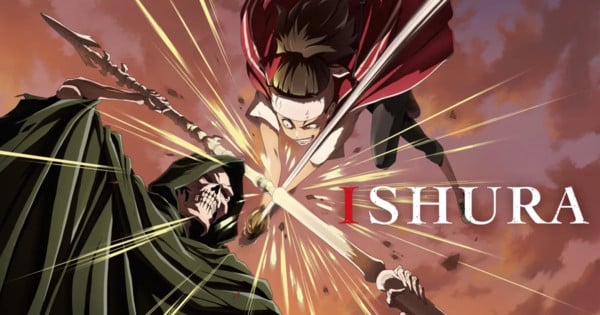Curated From www.animenewsnetwork.com Check Them Out For More Content.
Ishura is about the closest thing I’ve seen to a good old Fate-style Grail War in a while. We’ve got a huge cast of overpowered individuals with godlike abilities duking it out with one another over a vast canvas of multi-factional war. Everyone has their own agendas, belief systems, secrets, and goals. While the huge list of combatants in Ishura aren’t prominent historical figures, unlike in the various Fate series, they’ve all got big personalities and ostentatious special moves not dissimilar to Fate‘s Heroic Spirits. For one, everyone seems to have a ridiculously overblown title – I’m particularly fond of the invisible angel “Nastique the Quiet Singer” and poison-wielding mandrake plant person “Higuare the Pelagic.” Surely mechanical spider-riding “Nihilo the Vortical Stampede” wins through sheer edginess?
WhileIshura seems to take itself incredibly seriously with such silly names, it’s best enjoyed as a supremely daft, flashy action show. Thankfully, Ishura‘s spectacularly smooth, detailed, and kinetic action animation is more than adequate to provide enough spectacle to sate even the most jaded of violence addicts. The first episode starts as it means to go on, with a breathtaking battle between single-minded swordsman Soujirou the Willow-Sword and a hulking city-sized golem. Between the swooping camera, soaring orchestral music, and death-defying aerial swordplay, I was reminded positively of both Shadow of the Colossus and NieR:Automata, classic video games blessed with excellent soundtracks and nail-biting action against enormous, terrifying enemies.
Narratively, Ishura‘s experimental first half may be enough to discourage casual viewers – the show uses its initial six episodes as seemingly unconnected vignettes that introduce one or two primary members of its unfeasibly large cast while cramming in an impressive volume of complex world-building. This is a show where paying attention is mandatory, though the excellent production design and glossy presentation certainly help.
By episode seven, the primary players are thoroughly introduced, Ishura then switches to all-out battle mode as tensions between the breakaway city-state, the Principality of Lithia, and the Kingdom of Auretia reach breaking point. Lithia’s leader, “Taren the Punished,” declares herself the “New Demon King” and aims to unite the world beneath her rule, by fear, if necessary. She engages the help of several powerful warriors while Auretia sends some of their own. While many characters seem to fight for one side or another, some are more mercenary or don’t care about the war.
Not every combatant in Ishura is “minian” (the in-world term for human). “Regnejee the Wings of Sunset” and “Alus the Star Runner” are Wyverns whose battle rages in the skies as the city below them burns. Maybe I’m biased against lizard people, but I admit I found their scenes fairly dull, and the episode most prominently featuring Wyvern battles the least entertaining. However, Regnejee’s relationship with the sweet but blind “Curte of the Fair Skies” is one of the only truly emotional (and ultimately tragic) aspects of an otherwise very action-focused show.
Not content with throwing a huge cast of fantasy characters into a complex world and expecting the viewer to follow (perhaps by taking notes, making annotated diagrams, or re-watching multiple times), Ishura also randomly decides to be an isekai. Or, at least some characters are in an isekai. Sworsdman Sojiro and the tricksy “Dakai the Magpie” are both “Visitors” from another world; it remains to be seen if it’s meant to be ours. Visitors can’t use the Ishura world’s magic, which takes the form of “Word Arts,” but make up for it with other inhumanly powerful skills. Characters invoking their personal Word Arts trigger a cool multicolored blurred effect that reminds me of a migraine. I wish I could make enemies explode with the power of my migraines, but alas, I live in the real world.
Most of these characters are unique and well-differentiated from one another, though their sometimes limited screen time can make it difficult to root for them. Many of them die horribly, leaving only a handful alive at the conclusion, but the only one I mourned was the prodigiously murderous plant dude. I’m not sure if I’m meant to feel sad for an inhuman monster who just wanted to be left alone but found meaning in killing hundreds, if not thousands.
The one thing that frustrates me most about Ishura is that its promised tournament to decide the “True Hero” doesn’t even begin during this season, which means the entire thing is but a prologue to the real story. At least it’s been renewed for a second season, I’ll tune into that assured colosseum-based bloodbath for sure.
